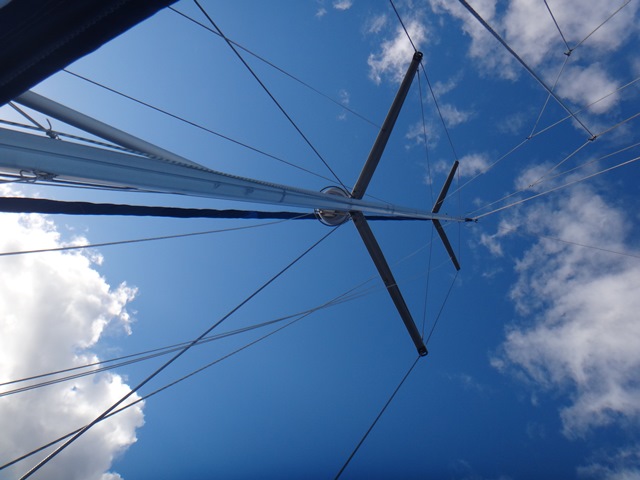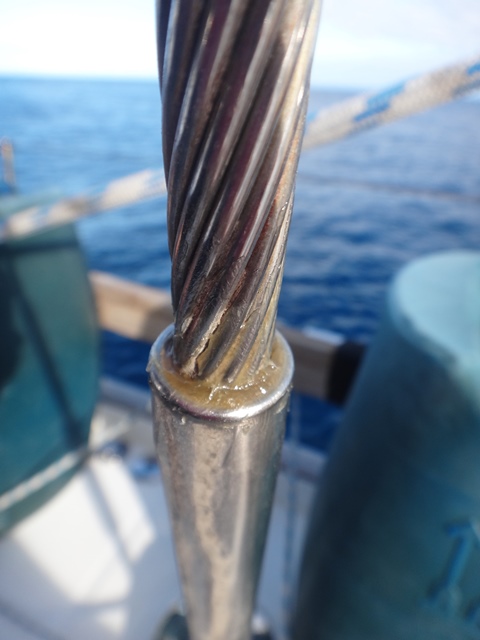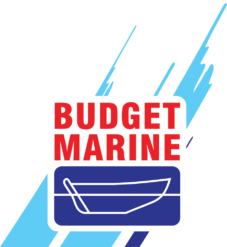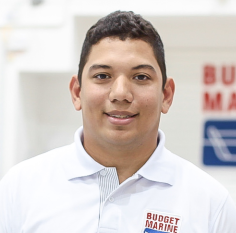Whether your boat is racing or cruising the functions and ideas for the rigging stay the same. While race boats use lighter rigs that take more strain, I believe a cruising boat’s kit is more at risk due to it’s constant exposure to the elements and the longer time it spends at sea at any one point. Stainless steel shrouds are great. They are strong, resistant to corrosion, and look good. One flaw though, you cannot determine if they are weakening or about to fail. The only way to know when you have a problem is when it happens. For this reason it is essential to have a plan B for the time when that happens. Spare cable with clamps is a great thing to have but these days there is dyneema and in a pinch when the weather and sea conditions are bad adding a section of spectra line with a trucker’s hitch to reinforce a damaged shroud is very easy and effective.
 You might not be able to tell the condition of a stainless shroud but this does not mean they mustn’t be checked. A rigging check should be performed before every major crossing and then at least once every few months. Get someone to pull you to the top of the mast and then slowly descent checking every connection for visible deterioration. You can tell when fittings are getting worn or split pins are missing. Check the areas where stainless meats aluminum, namely rivets. Check the electronics on the top of the mast while you’re there in case there is damage. Most importantly, check the ends of your shrouds where the cable enters the crimp. You can’t tell if it’s weak but you can tell the state in which the metal looks. If you see a bit of rust and dark colors that go away with a polish then you’re fine; but if you see thick rust with weeping runs of dark water that doesn’t clean up easily, you might need a replacement. To help protect these ends I shove a sticky anti corrosion product like Lanocot or Tef Gel into the crimped end to help repel salt water and slow down rust.
You might not be able to tell the condition of a stainless shroud but this does not mean they mustn’t be checked. A rigging check should be performed before every major crossing and then at least once every few months. Get someone to pull you to the top of the mast and then slowly descent checking every connection for visible deterioration. You can tell when fittings are getting worn or split pins are missing. Check the areas where stainless meats aluminum, namely rivets. Check the electronics on the top of the mast while you’re there in case there is damage. Most importantly, check the ends of your shrouds where the cable enters the crimp. You can’t tell if it’s weak but you can tell the state in which the metal looks. If you see a bit of rust and dark colors that go away with a polish then you’re fine; but if you see thick rust with weeping runs of dark water that doesn’t clean up easily, you might need a replacement. To help protect these ends I shove a sticky anti corrosion product like Lanocot or Tef Gel into the crimped end to help repel salt water and slow down rust.

Another large portion of your rigging is composed of rope. These sheets and halyards sometimes get forgotten because they will last for years if not chaffed. Even though they might not break, the lines have ulterior functions that get overlooked. Sheets for instance are designed to stretch. This stretch dampens the jarring forces of gusty wind or choppy seas on the sails. As the boat pounds into a wave and the genoa pulls forward against the impact the sheet should stretch reducing that force considerably. When the sheet is old and the stretch is gone, all that force is now transferred to shrouds or deck fittings. Remember to also pay close attention to chaff as boats will always have spots where lines will chaff regularly. Sometimes you can alter the area of chaff by filing it smooth or changing the diameter of the line but sometimes it cannot be avoided; the spinnaker halyard is one of these. When the spinnaker is flown for long passages, days at a time, the halyard at the top of the mast will undoubtedly start to chaff through. For this reason it is necessary to constantly change the position of the chaff by slightly lifting or dropped the sail. On top of that the halyard should be several meters longer than normal giving you the ability to cut off the end foot and remove the chaffed section all together.
Rigging is constantly attacked by the elements and strained by use but with a conscious eye and regular visual attention it should never fail.
Max Loubser
Ready Set Sail










